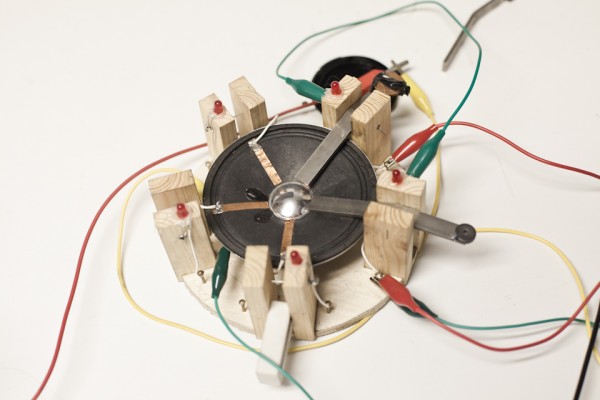Sound artist John M. Bowers created the Victorian Synthesizer out of technology available in the 19th century. Nicolas Collins, Professor in the Department of Sound at the School of the Art Institute of Chicago, offered instructions on how to build it in Handmade Electronic Music – The Art of Hardware Hacking (Routledge, 2009).
The synthesizer can be whittled down to a speaker, a battery, pieces of metal and wire to connect them. The speaker can be obtained from junk electronics from a thrift shop. A 9-volt battery will work. Pop tabs or spare change provide metal contacts. Wire is available at hardware stores, but alligator leads from Radio Shack or American Science and Surplus would be convenient.
Connect one battery terminal to one speaker terminal with an alligator lead. The “+” and “-“ will not matter. Connect another alligator lead to the second battery terminal. Touch the free end of the second lead to the free speaker terminal. The speaker will pop each time you touch it. You have just made a percussive electronic device!
Adding a third alligator lead and the bits of metal adds to the fun. Connect one speaker to one battery terminal. Connect the alligator lead from the other battery terminal to a bit of metal. The alligator clip will hold it in place. Connect the third alligator lead to the other speaker terminal and another bit of metal. Touch the bits of metal to complete the circuit and pop the speaker.
A third bit of metal will create new sounds. Touch the two bits of metal to another piece of metal with a different surface. Collins encourages, “the rougher or more corroded the metal surface, the better.”
To synthesize sounds, play with the metal bits over the speaker cone. By moving them around, you will be able to produce different buzzes. Collins suggests, “Put gravel, loose change, or dried lentils inside the cone for additional rhythmic accents. Place a can on the cone, open end down; clip one lead to the can and one to a metal washer placed on top of the can. The speaker cone will jump, breaking and remaking the contact as before, but in addition, as the can jiggles it changes resonance like a trumpet mute.”
Experiment with different materials and different batteries. Do not use AC power for your projects; it can kill you. Enjoy!
Handmade Electronic Music is available via http://www.nicolascollins.com/handmade.htm.


There are no voices yet... Post-script us a message below, won't you?